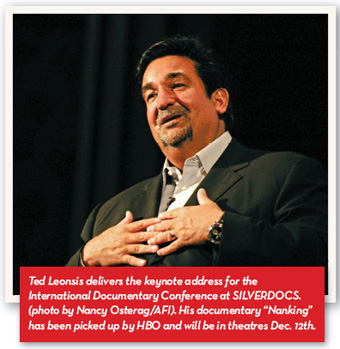
|
Ted Leonsis is a man on a mission.
He is delivering his keynote
speech at the SILVERDOCS
film festival on a quiet Thursday
afternoon to a small audience of filmmakers
and industry folk. The distributors and network
execs are sweating. Why? Because they’re
listening to a man known for finishing what
he starts. Today he is outlining his vision for
how the Internet can reshape the filmmaking
industry, encourage creativity and create a
more efficient distribution system. Leonsis sat
down with WL to discuss this and his concept
of “filmanthropy.”
WASHINGTON_LIFE__What is your assessment
of the business of filmmaking?
TED LEONSIS The business model is broken,
particularly for documentary filmmakers.
Basically, the way it’s set up today, everyone in
the value chain gets the money, except for the
guy who makes the movie. Let’s say you create
a documentary that makes $10 million dollars
at the box office – that means about a million
people saw it. That would make it one of the
top 10 documentaries of all time. But given the
economics of moviemaking, that filmmaker will
likely lose money. However, if you could get five
million people to watch your documentary for
free on the Internet, you can do a million dollars
in revenues through advertising. If you made it
for half a million, you’d be profitable.
WL It’s amazing to think that
documentaries like An Inconvenient Truth
still lose money in a scenario like this. Is
this a result of what you refer to as the
film industry’s “snail mail” mentality?
TL Exactly. In the old days, if you wanted to send
a letter, you’d have to sit down and write it, put
it in an envelope, put a stamp on it and walk it
to a little blue box. A stranger would come once
a day, open the blue box, take the letter to a big
concrete box, process it, put it on a truck to another
concrete box. Then put it into a bag and drive or
walk it to another house. There were thousands
of touchpoints.
That’s what happens today when you make a
movie. You make a movie and it gets printed. They
put the film into canisters, send them to a shipping
depot. The film goes into a truck and gets delivered
into a theater. That theater owner threads a |
film
projector and they show it, advertise it, and hope
people come in to see it and buy some popcorn.
In the movie business, we already have the
digital product – since movies are shot on HD.
Now we need to find a way to get it to the
millions and millions of people online, instead of in
a couple hundred theaters. AOL is already starting
to do that with “True Stories,” a site devoted to
showing new documentaries.
WL What are the impediments to
modernization?
TL The incumbents don’t want change
because they make money regardless.
Someone needs to get in and transform the
business from outside the industry and apply
different models and different rules.
WL Is that where “Filmanthropy”
comes in?
TL The most important thing about
filmanthropy is the metrics of success. Imagine
if I looked at my movie, Nanking, like I did
other business investments. I’m going to spend
two years of my life, travel to China, go to film
festivals, work my ass off, put a couple million
dollars of my own money into it and get no
revenues back? You wouldn’t do it. So if box
office and revenues are your metric of success,
you’d never make another film. But if righting a
wrong, changing a perception, activating healthy
debate and generating c h a r i t a b l e giving is
what your definition of success is, then you’d
make more films. What I’d like to do is create a
platform, a studio and a distribution means that
can make it easy for other people to m a k e f i l m s.  |

